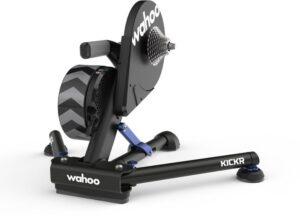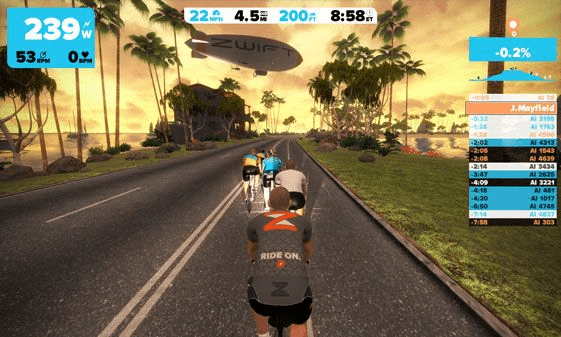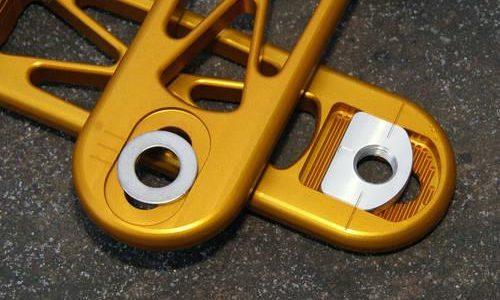Virtual cycling platform Zwift has become a go-to training ally for cyclists over the last few years, especially as more people took to indoor cycling during the pandemic.
Zwift is no longer just a winter training addition. The addictive nature of its gamified cycling and fun virtual worlds ensures cyclists will use the platform all year round.
Zwift describes itself as: ‘Zwift blends the fun of video games with the intensity of serious training, helping you get faster. Level up in the virtual worlds of Zwift with a community that motivates you every minute. Choose from training plans, group rides, races, and more. You’ll get fitter and stronger.’
What more could you want than to be able to cycle in the comfort of your own home, with your avatar cycling around a virtual world with stunning, immersive backdrops.
So, chances are you’ve already given Zwift a go (if you haven’t, you can get a free trial) and tried one of the many courses and routes available in Watopia – basically cycling paradise. But how do you improve Zwift performance and go faster?
What you need to get going on Zwift

Zwift performance is all about data accuracy. But to get started you need a turbo trainer (or rollers), stable internet connection and device (TV, laptop or mobile app), your bike and an ANT+ or Bluetooth measurement tool.
Some riders choose to opt for a basic sensor (speed / cadence) that hooks up to Zwift via the ANT+ stick, while others opt for a smart turbo trainer that delivers superior accuracy and more realistic resistance for hills and drafting.
Check out Zwift’s get Zwifting guide and its ‘How to: Ride’ section for a load of useful videos designed to help you get set up. Zwift’s shop also has everything you need to get pedalling.
For the complete experience, you’ll want a smart trainer that wirelessly hooks up to the platform to simulate the different terrain and conditions. Once ready, it’s simply a question of getting on your bike and pedalling to see your avatar start moving.
You can ride solo or as part of a group – there are thousands of riders on the platform who will join you on the roads regardless.
Cycling faster on Zwift
Speed, stamina and strength is a good starting point – obviously the more you cycle the more you’ll be able to build on those three principles. You can measure your progress on Zwift by looking at your speed and power metrics. Additionally, technique is important.
Cycling on a stationary bike is slightly different to being out on the road so things like climbing out of your seat will naturally feel slightly different.
Generally, you want to ensure you are in an efficient and comfortable position. You can also use the Zwift structured workouts to boost your performance and training specific areas of your cycling, such as hill climbing.
Ultimately, the biggest factor when it comes to speed is power. Assess your current levels of wattage and how long you can hold that for, and that’s what you want to improve.
After the physical performance, cycling on Zwift is all about metrics and data. Data and cycling go hand in hand today, and that’s why you’ll see heart rate, power output, speed, cadence, elevation and total distance on your Zwift dashboard. All of these metrics can be improved and are designed to motivate your riding.

Zwift uses the data you generate to calculate your speed within the game. This takes into account your own personal details such as rider weight, as well as the terrain you are cycling on, and whether or not you are cycling on your own or drifting in the middle of a pack.
As in real-world cycling, drifting by sitting on the back wheel of another cyclist is a nice way to boost your speed.
FAQ
Does Zwift make you faster?
Cycling on Zwift means you don’t need to worry about cars, traffic lights, potholes and more. So Zwift is a smoother and cleaner cycling experience than in many outdoor situations.
However, the speed and distance calculations are different to real-world cycling so there are instances where you will appear faster (or slower) than what you’d expect in real life.
Additionally, for group rides and workouts, the platform is designed to keep riders together, so the result is cyclists actually feel slower than normal. Slower riders in the group may feel faster than normal in comparison.
How does Zwift’s speed calculation work?
Zwift’s speed calculation is determined by:
- Wattage: the more power you are putting into the pedals, the faster you will go.
- Terrain: the various terrains in Zwift (road gradient, surfaces, draft effects) impact the speed of your avatar.
- Weight: the lighter you are the faster your avatar will go on flats and climbs, but heavier riders will descend faster.
- Height: Shorter riders are more aerodynamic so will go faster if both riders are putting out the same wattage and are the same weight.
- Bike choice: Each frame and wheelset in Zwift has a weight and aero value assigned to it which impacts speed.
How does Zwift calculate distance?
Unlike your Garmin device, Zwift calculates distance by looking at speed and power. Garmin calculates distance based on wheel revolutions. So the distance metrics won’t match.
Plus, as Zwift mirrors real-world physics, it won’t return the same distance number as if you were cycling at exactly the same wattage and cadence outside.
Can one cheat on Zwift?
In short, yes. If you’ve ridden on the platform previously you’ve likely experienced the odd amateur cyclist that is literally flying around the route. Some of this is intentional, some of this is unintentional.
Ultimately, Zwift works based on numbers, so if the numbers being input into the platform are skewed then so will the rider’s speed be. It all comes down to the accuracy of data – the higher-spec your turbo trainer and set up, the more accurate your data will be.
Examples include submitting a fake weight to go faster, which messes up your watt/kg calculation or hacking your smart training to boost your power readings. Think of it as Zwift doping!

Founder of Vivi Nation, the cycling, running and active living brand. Chris is a sports enthusiast, occasional triathlete and experienced cyclist, having led multiple cycle tours across Europe.


